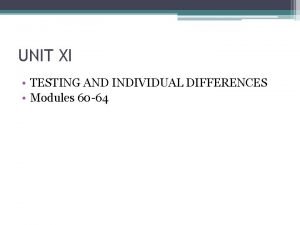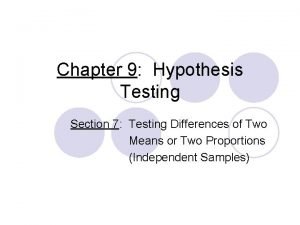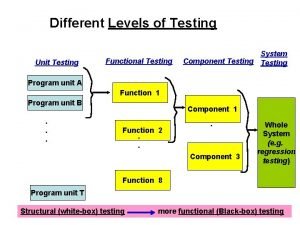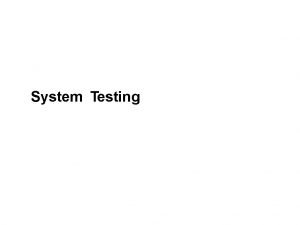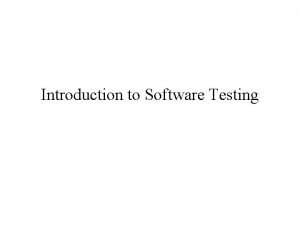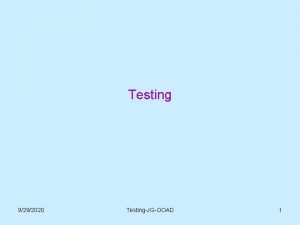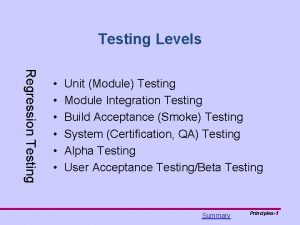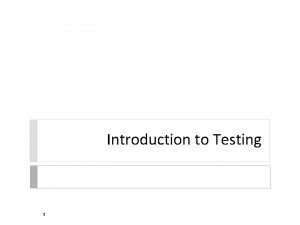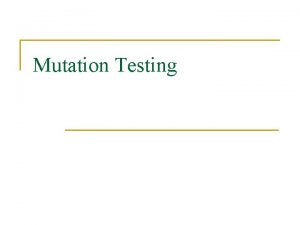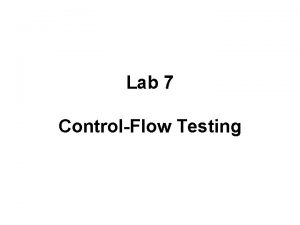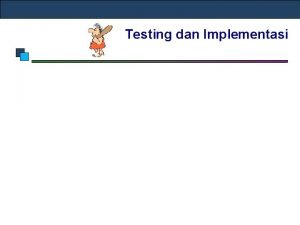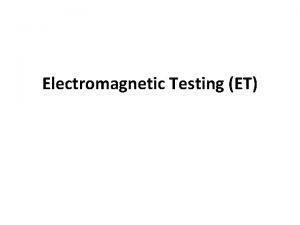Chapter 9 Testing for Differences l l Differences


































- Slides: 34

Chapter 9 Testing for Differences l l Differences betweens groups or categories of the independent variable Statistical tests of difference reveal whether the differences observed are greater than differences that might occur by chance – – – 1 Chi-square t-test ANOVA Introduction to Communication Research, BU-CA

Inferential Statistics l l Statistical test used to evaluate hypotheses and research questions Results of the sample assumed to hold true for the population if participants are – – l 2 Normally distributed on the dependent variable Randomly assigned to categories of the IV Caveats of application Introduction to Communication Research, BU-CA

Alternative and Null Hypotheses l l Inferential statistics test the likelihood that the alternative hypothesis is true and the null hypothesis is not Significance level of. 05 is generally the criterion for this decision – – 3 If p . 05, then alternative hypothesis accepted If p >. 05, then null hypothesis is retained Introduction to Communication Research, BU-CA

Degrees of Freedom l l l 4 Represented by df Specifies how many values vary within a statistical test Collecting data always carries error df help account for this error Rules for calculating df or each statistical test Introduction to Communication Research, BU-CA

Four Analytical Steps 1. 2. 3. 4. 5 Statistical test determines if a difference exists Examine results to determine if the difference found is the one predicted Is the difference significant? Evaluate the process and procedures of collecting data Introduction to Communication Research, BU-CA

Chi-Square l l Represented as χ2 Determines if differences among categories are statistically significant – – l 6 Compares the observed frequency with the expected frequency The greater the difference between observed and expected, the larger the χ2 Data for one or more variables must be nominal or categorical Introduction to Communication Research, BU-CA

One-Dimensional Chi-Square l l l 7 Determines if differences in how cases are distributed across categories of one nominal variable are significant Significant χ2 indicates that variation of frequency across categories did not occur by chance Does not indicate where the significant variation occurs – only that one exists Introduction to Communication Research, BU-CA

Contingency Analysis l l Also known as two-way chi-square or twodimensional chi-square Examines association between two nominal variables in relationship to one another – – – 8 Columns represent frequencies of 1 st variable Rows represent frequencies of 2 nd variable Frequency of cases that satisfy conditions of both variables inserted into each cell Introduction to Communication Research, BU-CA

Limitations of Chi-Square Can only use nominal data variables l Test may not be accurate l – – l 9 If observed frequency is zero in any cell, If expected frequency is < 5 in any cell Cannot directly determine causal relationships Introduction to Communication Research, BU-CA

t-Test l l Represented by t Determines if differences between two groups of the independent variable on the dependent variable are significant – – 10 IV must be nominal data of two categories DV must be continuous level data at interval or ratio level Introduction to Communication Research, BU-CA

Commons Forms of t-Test l Independent sample t-test – l Paired comparison t-test – 11 Compares mean scores of IV for two different groups of people Compares mean scores of paired or matched IV scores from same participants Introduction to Communication Research, BU-CA

Types of t-Tests l Two-tailed or nondirectional t-test – l One-tailed or directional t-test – 12 Hypothesis or research question indicates that a difference in either direction is acceptable Hypothesis or research question specifies the difference to be found Introduction to Communication Research, BU-CA

Limitations of t-Test l l 13 Limited to differences of two groupings of one independent variable on one dependent variable Cannot examine complex communication phenomena Introduction to Communication Research, BU-CA

Analysis of Variance l l l 14 Referred to with acronym ANOVA Represented by F Compares the influence of two or more groups of IV on the DV One or more IVs can be tested -- must be nominal -- can be two or more categories DV must be continuous level data Introduction to Communication Research, BU-CA

ANOVA Basics l Planned comparisons – l Unplanned comparisons, or post hoc comparisons – 15 Comparisons among groups indicated in the hypothesis Not predicted by hypothesis -- conducted after test reveals a significant ANOVA Introduction to Communication Research, BU-CA

ANOVA Basics l l l 16 Between-groups variance – differences between groupings of IV are large enough to distinguish themselves from one another Within-groups variance – variation among individuals within any category or grouping For significant ANOVA, between-groups variance is greater than within-groups variance Introduction to Communication Research, BU-CA

ANOVA Basics l l F is calculated to determine if differences between groups exist and if the differences are large enough to be significantly different A measure of how well the categories of the IV explain the variance in scores of the DV – 17 The better the categories of the IV explain variation in the DV, the larger the F Introduction to Communication Research, BU-CA

ANOVA Design Features l Between-subjects design – l Within-subject design – – 18 Each participant measured at only one level of only one condition Each participant measured more than once, usually on different conditions Also called repeated measures Introduction to Communication Research, BU-CA

One-Way ANOVA l Tests for significant differences in DV based on categorical differences of one IV – – l Significant F – 19 One IV with at least two nominal categories One continuous level DV Difference between groups is larger than difference within groups Introduction to Communication Research, BU-CA

Two-Way ANOVA l Determines relative contributions of each IV to the distribution of the DV – – l l 20 Two nominal IVs One continuous level DV Can determine main effect of each IV Can determine interaction effect -- if there is a simultaneous influence of both IVs Introduction to Communication Research, BU-CA

Example of Two-Way ANOVA 21 Male Female One-sided news report Males viewing one-sided news report Females viewing one-sided news report Two-sided news report Males viewing two-sided news report Females viewing two-sided news report Introduction to Communication Research, BU-CA

Main and Interaction Effects l l 22 Main Effect Unique contribution of each IV One IV influences scores on the DV and this effect is not influenced by other IV l l Interaction Effect One IV cannot be interpreted without acknowledging other IV If interaction effect exists, main effects are ignored Introduction to Communication Research, BU-CA

Limitations of ANOVA 23 l Restricted to testing IV of nominal or categorical data l When 3 or more IVs used, can be difficult and confusing to interpret Introduction to Communication Research, BU-CA

Tests of Differences 24 Introduction to Communication Research, BU-CA

Testing for Relationships l Tests of linear relationships – Correlation l – Regression l l 25 2 continuous level variables 2 or more continuous level variables Identifies statistically significant linear patterns in the association of variables Introduction to Communication Research, BU-CA

Basic Assumptions l l 26 Data collected from sample to draw conclusion about population Data from normally distributed population Appropriate variables are selected to be tested using theoretical models Participants randomly selected Introduction to Communication Research, BU-CA

Alternative and Null Hypotheses l l Inferential statistics test the likelihood that the alternative hypothesis is true and the null hypothesis is not Significance level of. 05 is generally the criterion for this decision – – 27 If p . 05, then alternative hypothesis accepted If p >. 05, then null hypothesis is retained Introduction to Communication Research, BU-CA

Four Analytical Steps 1. 2. 3. 4. 28 Statistical test determines if a relationship exists Examine results to determine if the relationship found is the one predicted Is the relationship significant? Evaluate the process and procedures of collecting data Introduction to Communication Research, BU-CA

Correlation l l l Also known as Pearson product-moment correlation coefficient Represented by r Correlation reveals if – – – 29 Scores on both variables increase or decrease Scores on one variable increase while scores on the other variable decrease There is no pattern or relationship Introduction to Communication Research, BU-CA

Correlation l Correlation coefficient or r reveals the degree to which two continuous level variables are related – l l If r is . 05, then the relationship is significant – hypothesis or research question accepted Correlation cannot necessarily determine causation – – – 30 Participants provide measures of two variables X causes Y Y causes X Third variable causes both Introduction to Communication Research, BU-CA

Interpreting the Coefficient Direction of relationship Positive- both variables increase/decrease Negative – one variable increases while the other decreases 31 Relationship strength <. 20 – slight, almost negligible. 20 -. 40 – low, definite but small. 40 -. 70 – moderate, substantial. 70 -. 90 – high; marked >. 90 – very high or dependable Introduction to Communication Research, BU-CA

Amount of Shared Variance l l l r 2 – represents the percentage of variance two variables have in common Known as coefficient of determination Found by simply squaring r l l l l 32 . 2 or -. 2 =. 04 r 2. 3 or -. 3 =. 09 r 2. 4 or -. 4 =. 16 r 2. 5 or -. 5 =. 25 r 2. 6 or -. 6 =. 36 r 2. 7 or -. 7 =. 49 r 2. 8 or -. 8 =. 64 r 2. 9 or -. 9 =. 81 r 2 Introduction to Communication Research, BU-CA

Other Forms of Correlation l Point biserial correlation – l Spearman correlation coefficient or rho – l 33 One continuous level variable, other measured at one of two nominal levels Both variables are ordinal scale data Both interpreted for their direction and strength Introduction to Communication Research, BU-CA

Limitations of Correlation l l l Can only examine relationship between 2 variables Any relationship is presumed to be linear Limited in the degree to which inferences can be made – – 34 Correlation does not necessarily equal causation Causation depends on the logic of relationship Introduction to Communication Research, BU-CA
 Unit xi testing and individual differences
Unit xi testing and individual differences Domain testing
Domain testing Motivational overview in software testing
Motivational overview in software testing Du path testing
Du path testing Positive testing and negative testing
Positive testing and negative testing Cs3250
Cs3250 What is globalization testing
What is globalization testing Neighborhood integration testing
Neighborhood integration testing What is testing
What is testing Control structure testing in software testing
Control structure testing in software testing Decision table testing in software testing
Decision table testing in software testing Decision table technique
Decision table technique Pengertian black box
Pengertian black box Behavior testing adalah
Behavior testing adalah Extended decision table
Extended decision table Rigorous testing in software testing
Rigorous testing in software testing Testing blindness in software testing
Testing blindness in software testing Component testing is a black box testing
Component testing is a black box testing Types of domain testing
Types of domain testing Fspos
Fspos Novell typiska drag
Novell typiska drag Nationell inriktning för artificiell intelligens
Nationell inriktning för artificiell intelligens Returpilarna
Returpilarna Shingelfrisyren
Shingelfrisyren En lathund för arbete med kontinuitetshantering
En lathund för arbete med kontinuitetshantering Adressändring ideell förening
Adressändring ideell förening Tidböcker
Tidböcker Sura för anatom
Sura för anatom Förklara densitet för barn
Förklara densitet för barn Datorkunskap för nybörjare
Datorkunskap för nybörjare Stig kerman
Stig kerman Mall för debattartikel
Mall för debattartikel För och nackdelar med firo
För och nackdelar med firo Nyckelkompetenser för livslångt lärande
Nyckelkompetenser för livslångt lärande Påbyggnader för flakfordon
Påbyggnader för flakfordon
